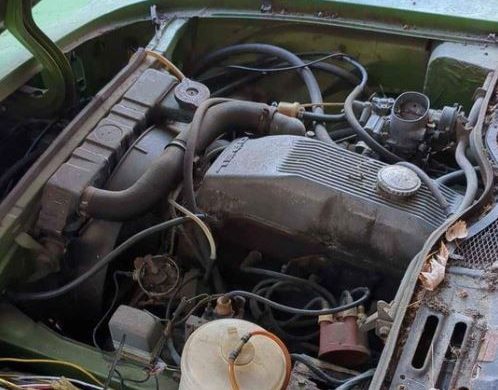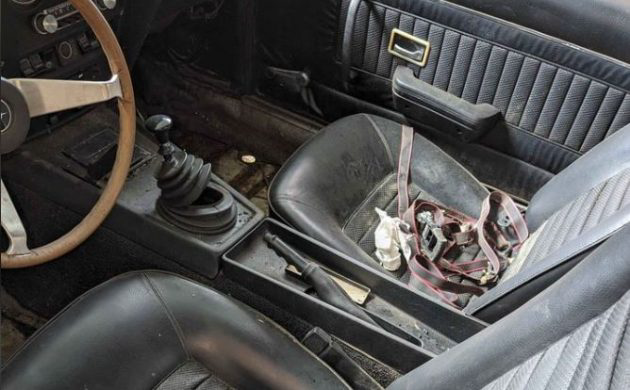
Here’s another “ran when parked” prospect on facebook Marketplace – a 1973 Opel GT, located in Dayton, Ohio with an asking price of $2500. The sleek two-seater was an unlikely product of Opel Automobile, founded in 1862 in Germany to make sewing machines. For a few years, the company followed a predictable path, producing bicycles and then automobiles. In 1927, Opel took a turn off the rails with its RAK program, which amounted to affixing rockets to all manner of conveyances, from cars to motorbikes to – finally – planes. But its primary business had become carmaking, which by 1929 enticed General Motors to take a controlling stake in Opel. GM purchased the company outright in 1931. For decades, Opel soldiered away making unexciting family cars mostly for European markets; when its cars came to the US, Buick was assigned to sell them. The results were desultory. Opel asked for a change in its design studio, which arrived in the form of Clare MacKichan, responsible for the Tri-Five Chevy among other automotive hits. MacKichan spearheaded Opel’s sports car project, and after many fits and starts, the Opel GT was launched for model year 1968. Sales were respectable, with about 70% going to the US, but the car didn’t survive the advent of bumper and safety regulations. This ’73 is from the last year of production, and it needs a full restoration. Ted sent us this tip – thanks, Ted!

Two engines were available – a 1.1-liter four, or the 96 hp 1.9-liter four. Power ratings declined over the years due to emissions regulations. A common swap is from the original Solex to a Weber – but that’s not a cure-all for the horsepower deficit. Gearboxes also came in two flavors – a three-speed automatic or a four-speed manual. This car has the latter; the seller notes both the engine and transmission “worked good” but he advises that the front calipers need replacing and the fuel system should be flushed. I’d say that’s the tip of the iceberg.

The interior was suitably sporty from the factory with neat buckets, a three-spoke wood-rimmed wheel, and a generous supply of gauges. Of course, this one will need renovation, with niggling problems everywhere. The cool headlights operate manually via a console lever, flipping open around a horizontal axis.

Though the Opel GT is styled as a fastback, it doesn’t have a hatch that opens, nor a trunk. Storage is accessed by reaching behind the seats – à la the Bugeye Sprite. This example is plagued by surface rust – so no saving that paint. While the initial price seems reasonable, and parts are available, once again we must weigh time and trouble against the price of this perfectly good driver, which sold for $22k recently. What would you pay for this yard resident?







I kind of liked these, sporty and cute with plenty of styling.
For what it’s worth, I believe those license plates are from the late 1980’s, maybe1988.
I remember when these came out. To me they looked fabulous in the GM dealer brochures, a sort-of “baby Corvette”. When I saw my first one at the dealership, I was disappointed. The proportions just didn’t seem quite right.
My dad’s young legal secretary got one of the very first examples. It turned out to be the most unreliable car she ever owned. While it was sold by the local Pontiac-Buick dealer, it was completely foreign (pun intended) to the Service/Parts Dept. They were not properly prepared or trained by GM, and parts availability was an issue then too. She traded it in on a Firebird in less than a year.
They didn’t sell well in North America, and GM declined to invest in upgrading design to new safety regs after ’73. Opel GTs were not very popular with dealers. GM forced dealers to accept them, tying allotment to other popular models. They couldn’t order Firebirds, if they didn’t take some Opels!
Many were sold at/below dealer cost, or used for contest giveaways. The same happened when GM dealers were stuck (briefly) selling the Vauxhall Firenza.
They do have a (relatively small) following, and most issues now have a fix. The biggest problem with Opel GTs is Rust, although most cars built then shared the same weakness. The car here does appear to have (at least) moderate rust. The cost and effort to properly repair it makes it a losing proposition. Nice ones are somewhat rare, but rare does not always mean valuable. Decent drivers start around $10K.
GM never did know how to treat their imports. They didn’t stock parts, train mechanics, etc. And then they wondered why they didn’t sell. GM lost money on Opel for 20 years before selling it to Peugeot. Peugeot turned a profit within 3years.
Friends owned two (2) back in the day, my brother and me each owned a 1900/Manta Rallye. More GT’s have survived than the Manta/1900 twins, but in all cases, attacks of the dreaded “tin worm” have sent most of these to the crusher. Opel recently built a show car out of a Manta, with an electric motor coupled to the stock four-speed manual gearbox! Fun Fact: The GT was Maxwell Smart’s second (2nd) ride, after his Sunbeam Tiger, but before he got a VW Karmann Ghia as his personal vehicle in the final season of “Get Smart”!
The flip up headlight buckets have rust holes on them. This bad boy has many more hidden secrets.
I believe in 1973 the only engine was the 96 hp 1.9-liter four. This was the best motor to get out of all of the years. I’d want to see the underside – these were prone to rust
I have owned 3 Opel Kadettes including a 1970 Rallye. I added a Weber carb, manual choke, and a few other goodies. Driving the Rallye with the 4 speed was a real hoot. It felt like a real sports car. It had a full set gauges below the dash and it just challenged you to push a little harder. However, it was totally forgiving if you messed up. I was sorry the minute I sold it (although the Datsun 510 that replaced it was also fun). :)
This example is for fanboys (and girls) only! This one needs a full rotisserie restoration of its unibody, which starts with a complete stripping of all of the paint down to bare metal, using your preferred method (media blasting or chemical stripping), so you can see where all of the rust is. If the “frame” rails are rotted, then it may become a parts donor, as the cost to repair the damage may exceed the value of the finished product. Even if you accept that fact and decide to take this on, this one will take a lot of time and money to restore.
In the Kate 70s early 80s teenagers like myself picking up musical cars for cheap a kids dad had a 73 opal same as this one her brought it back to life the metallic green paint the car looked awesome and u didn’t see anything else like it around lol I respect that. Just saying it’s not always about the dollars
I had quite a few and from what I remember the 69 and 70 had more horsepower and also those years had one reverse light below license plate. By 73 I believe some 72 and all 73 reverse lights where in the two inner tail lights. Just remembering from years ago. I’m no expert.
Three of my favorite cars were Opels. Two GTs and a Manta Rallye. The GT was more fun than the under 100 horsepower would indicate. A set of radial T/As and it cornered nicely. The tin worm was always a problem, but nothing like my wife’s Datsun that took 2 gallons of bondo to fill all the rust holes in a 4 year old car.
This looks mostly surface, if the battery didn’t eat a big hole, the body itself looks salvageable.
Big fun, and cheap. What can go wrong ;-)
Suffering in the thrall of the Opel Kadett Rallye myself. Who knows why. Sigh.
The Pontiac Saturn Opel cabrio is the one not that abomination in the article.
Those old Opel GTs have bad sheet metal from the factory very thin low zinc content prone to rust, what you see isn’t a surface problem it’s all the way through the chassis everywhere.
It’s a Death trap.
The early 2000s Pontiac Saturn Opel Cabriole on the other hand is WORTHY & the Opel GT model is down right flashy in Silver Paint & Chrome trim.
Their affordable & have decent modern drive trains & serviceable components that are from the GM parts bin easily picked up cheap in Junkyards as pick a part.
I’ve seen a few their sorta Rare actually & the last yr Coupe Solstice is rising in value.
The opel gt was in fact a nice looking car but it is true gm ignored it and payed no attention to it
Opel GTs was assembled by Renault in France. The body and underpinnings were made on contract, and Engines, manual gearboxes, and brake parts came from GM.
Very much loved by tin worms. Terrible rust protecting.
The bodies came from Brissoneau et Lotz, better known as an aircraft manufacturer, with ordinary Open running gear.
No title for this one either. That could turn into a nightmare by itself. Seems like a lot for what you’re getting. (Or lack of)